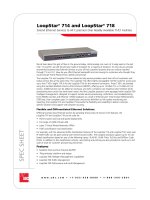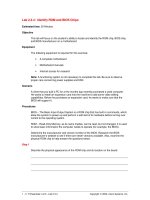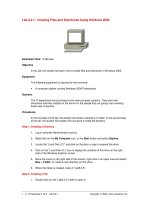Tài liệu RFID technology and Applications docx
Bạn đang xem bản rút gọn của tài liệu. Xem và tải ngay bản đầy đủ của tài liệu tại đây (2.91 MB, 244 trang )
This page intentionally left blank
RFID Technology and Applications
Are you an engineer or manager working on the development and implementation
of RFID technology? If so, this book is for you.
Covering both passive and active RFID, the challenges to RFID implementa-
tion are addressed using specific industry research examples as well as common
integration issues. Key topics such as performance optimization and evaluation,
sensors, network simulation, RFID in the retail supply chain, and testing are
covered, as are applications in product lifecycle management in the automotive
and aerospace sectors, in anti-counterfeiting, and in health care.
This book brings together insights from the world’s leading research
laboratories in the field, including MIT, which developed the Electronic Product
Code (EPC) scheme that is set to become the global standard for object-
identification.
MIT’s suite of Open Source code and tools for RFID implementation is
currently being developed and will be made available with the book (via www.
cambridge.org/9780521880930).
This authoritative survey of core engineering issues, including trends and key
business questions in RFID research and practical implementations, is ideal for
researchers and practitioners in electrical engineering, especially those working on
the theory and practice of applying RFID technology in manufacturing and
supply chains, as well as engineers and managers working on the implementation
of RFID.
Stephen B. Miles is an RFID evangelist and Research Engineer for the Auto-ID
Lab at MIT. He has over 15 years of experience in computer network integration
and services.
Sanjay E. Sarma is currently an Associate Professor at MIT, and is also a
co-founder of the Auto-ID Center there. He serves on the board of EPCglobal,
the wordwide standards body he helped to start up.
John R. Williams is Director of the Auto-ID Lab at MIT, and is also a Professor of
Information Engineering in Civil and Environmental Engineering. As well as
many years of lecturing, has also worked in industry, and was the Vice President
of Engineering at two software start-up companies.
The Auto-ID Lab at MIT has developed a suite of RFID and software
specifications for an Electronic Product Code (EPC) network that have been
incorporated into EPCglobal and ISO standards and are being used by over 1,000
companies across the globe.
RFID Technology
and Applications
Edited by
STEPHEN B. MILES
SANJAY E. SARMA
JOHN R. WILLIAMS
Massachusetts Institute of Technology
CAMBRIDGE UNIVERSITY PRESS
Cambridge, New York, Melbourne, Madrid, Cape Town, Singapore, São Paulo
Cambridge University Press
The Edinburgh Building, Cambridge CB2 8RU, UK
First published in print format
ISBN-13 978-0-521-88093-0
ISBN-13 978-0-511-39669-4
© Cambridge University Press 2008
2008
Information on this title: www.cambridge.org/9780521880930
This publication is in copyright. Subject to statutory exception and to the provision of
relevant collective licensing agreements, no reproduction of any part may take place
without the written
p
ermission of Cambrid
g
e University Press.
Cambridge University Press has no responsibility for the persistence or accuracy of urls
for external or third-party internet websites referred to in this publication, and does not
g
uarantee that any content on such websites is, or will remain, accurate or a
pp
ro
p
riate.
Published in the United States of America by Cambridge University Press, New York
www.cambridge.org
eBook (NetLibrary)
hardback
Contents
List of contributors page xi
Preface xv
Acknowledgments xxi
1 Introduction to RFID history and markets 1
Stephen Miles
1.1 Market assessment 3
1.2 Historical background 4
1.3 Adoption of the Auto-ID system for the Electronic
Product Code (EPC) 6
1.4 EPC information services 8
1.5 Methodology – closing the loop 9
1.6 RFID investing in a better future 10
1.7 New business processes 12
1.8 References 13
2 RFID technology and its applications 16
Sanjay Sarma
2.1 The first wave: the state of EPC technology 16
2.2 On the future of RFID technology 21
2.3 Applications 25
2.4 Conclusions 30
2.5 References 30
3 RFID tag performance optimization: a chip perspective 33
Hao Min
3.1 Metrics of tag performance 33
3.2 Performance enhancement of RFID tags 36
3.3 Sensors for RFID; integrating temperature sensors
into RFID tags 44
3.4 References 46
4 Resolution and integration of HF and UHF 47
Marlin H. Mickle, Leonid Mats, and Peter J. Hawrylak
4.1 Introduction 48
4.2 Basics of the technologies 48
4.3 Fundamentals of orientation 50
4.4 Antennas and materials 53
4.5 An analogy to network layering 55
4.6 Examples of converging technologies 57
4.7 Technical summary 57
4.8 Pharma – a surrogate for the future 59
4.9 References 60
5 Integrating sensors and actuators into RFID tags 61
J. T. Cain and Kang Lee
5.1 Introduction 61
5.2 RFID systems 61
5.3 ‘‘Smart’’ transducers 63
5.4 RFID tags with sensors 68
5.5 Conclusion 72
5.6 Acknowledgment 72
5.7 References 72
6 Performance evaluation of WiFi RFID localization technologies 74
Mohammad Heidari and Kaveh Pahlavan
6.1 Introduction 75
6.2 Fundamentals of RFID localization 76
6.3 Performance evaluation 80
6.4 Summary and conclusions 84
6.5 Acknowledgments 84
6.6 References 86
7 Modeling supply chain network traffic 87
John R. Williams, Abel Sanchez, Paul Hofmann, Tao Lin, Michael Lipton,
and Krish Mantripragada
7.1 Introduction and motivation 87
7.2 Requirements 88
7.3 Software architecture 91
7.4 Implementation 93
7.5 Simulator performance 96
7.6 References 97
7.7 Appendix 97
Contentsvi
8 Deployment considerations for active RFID systems 101
Gisele Bennett and Ralph Herkert
8.1 Introduction 101
8.2 Basics of the technologies 102
8.3 Technology and architectural considerations 103
8.5 Testing for RFID performance and interference 109
8.6 References 111
9 RFID in the retail supply chain: issues and opportunities 113
Bill C. Hardgrave and Robert Miller
9.1 Introduction 113
9.2 From partial to full supply chain coverage 113
9.3 Store execution 115
9.4 Data analytics 118
9.5 Conclusion 119
9.6 References 119
10 Reducing barriers to ID system adoption in the aerospace
industry: the aerospace ID technologies program 121
Duncan McFarlane, Alan Thorne, Mark Harrison, and Victor Prodonoff Jr.
10.1 Introduction 121
10.2 Background 121
10.3 The Aero ID consortium 123
10.4 Defining a research program 125
10.5 Research developments 127
10.6 Trials and industrial adoption 137
10.7 Summary 142
10.8 Bibliography 143
11 The cold chain 144
J. P. Emond
11.1 The food industry 144
11.2 Pharmaceuticals 146
11.3 Types of temperature-tracking technologies 147
11.4 Challenges associated with RFID temperature-tracking
technologies 149
11.5 Potential applications in ‘‘semi- and real-time’’ cold chain
management 153
11.6 References 155
Contents vii
12 The application of RFID as anti-counterfeiting technique: issues
and opportunities 157
Thorsten Staake, Florian Michahelles, and Elgar Fleisch
12.1 Counterfeit trade and implications for affected enterprises 157
12.2 The use of RFID to avert counterfeit trade 159
12.3 Principal solution concepts based on RFID 162
12.4 Migration paths and application scenarios 166
12.5 Conclusion 167
12.6 References 167
13 Closing product information loops with product-embedded
information devices: RFID technology and applications, models and metrics 169
Dimitris Kiritsis, Hong-Bae Jun, and Paul Xirouchakis
13.1 Introduction: closing the product information loop 169
13.2 The concept of closed-loop PLM 171
13.3 The state of the art 173
13.4 System architecture 174
13.5 A business case of PROMISE on ELV recovery 176
13.6 Product usage data modeling with UML and RDF 177
13.7 Conclusion 181
13.8 Acknowledgments 181
13.9 References 181
14 Moving from RFID to autonomous cooperating logistic processes 183
Bernd Scholz-Reiter, Dieter Uckelmann, Christian Gorldt, Uwe Hinrichs, and Jan Topi Tervo
14.1 Introduction to autonomous cooperating logistic processes
and handling systems 183
14.2 Radio frequency – key technology for autonomous logistics 185
14.3 RFID-aware automated handling systems – the differentiator
between intelligent objects and autonomous logistics 192
14.4 Conclusion 195
14.5 References 195
15 Conclusions 198
Stephen Miles, Sanjay Sarma, and John Williams
15.1 Radio frequency gap analyses; Georgia Tech LANDmark
Medical Device Test Center 199
15.2 The RFID Technology Selector Tool; Auto-ID Labs at
Cambridge University 199
15.3 An EPC GenII-certified test laboratory; the RFID Research
Center, University of Arkansas 200
Contentsviii
15.4 ISO 18000-7 and 6c (HF and UHF) RFID and
EPC network simulation 200
15.5 RFID anti-counterfeiting attack models; Auto-ID Labs at
St. Gallen and the ETH Zu
¨
rich 203
15.6 Adding sensors to RFID Systems – IEEE 1451/NIST
interface specifications 204
15.7 Adding location interfaces 205
15.8 Convergence of RFID infrastructure: multi-frequency and
multi-protocol 207
15.9 New business processes: from e-Pedigree to VAT tax compliance 208
15.10 References 211
Appendix – links to RFID technology and applications resources 213
Editor biographies 215
Index 217
Contents ix
Contributors
Gisele Bennett
Professor and Director, Electro-Optical Systems Laboratory, Georgia Tech
Research Institute, Georgia Institute of Technology, Atlanta, GA – Ch. 8
J. T. Cain
Professor, Department of Electrical and Computer Engineering, University of
Pittsburgh, Pittsburgh, PA – Ch. 5
J. P. Emond
Associate Professor and Co-Director, IFAS Center for Food Distribution and
Retailing, University of Florida, Gainesville, FL – Ch. 11
Elgar Fleisch
Professor and Director, Auto-ID Labs, University of St. Gallen, Institute
of Technology Management and Eidgeno¨ssische Technische Hochschule
Zu
¨
rich, Zurich, Department of Management, Technology and Economics –
Ch. 12
Christian Gorldt
Bremer Institut fu
¨
r Produktion und Logistik GmbH (BIBA), University of Bremen,
Bremen – Ch. 14
Bill C. Hardgrave
Associate Professor and Executive Director, RFID Research Center, Sam M.
Walton College of Business, University of Arkansas, Fayetteville, AR – Ch. 10
Mark Harrison
Senior Research Associate, Auto-ID Labs, University of Cambridge, Cambridge –
Ch. 10
Peter J. Hawrylak
RFID Center of Excellence, University of Pittsburgh, Pittsburgh, PA – Ch. 4
Mohammad Heidari
Center for Wireless Information Network Studies (CWINS), Worcester Poly-
technic Institute, Worcester, MA – Ch. 6
Ralph Herkert
Senior Research Engineer, Medical Device Test Center, Georgia Tech Research
Institute, Georgia Institute of Technology, Atlanta, GA – Ch. 8
Uwe Hinrichs
Bremer Institut fu
¨
r Produktion und Logistik GmbH (BIBA), University of Bremen,
Bremen – Ch. 14
Paul Hofmann
Director External Relations, SAP Research Center, Palo Alto, CA – Ch. 7
Hong-Bae Jun
Ecole Polytechnique Fe
´
de
´
rale de Lausanne, Lausanne – Ch. 13
Dimitris Kiritsis
Associate Director, Laboratory of Informatics for Design and Production, Ecole
Polytechnique Fe
´
de
´
rale de Lausanne, Lausanne – Ch. 13
Kang Lee
National Institute of Standards and Technology (NIST), Washington, DC – Ch. 5
Tao Lin
Director of Auto-ID Infrastructure, SAP Labs LLC, Palo Alto, CA – Ch. 7
Michael Lipton
Director of RFID Solutions Management for Healthcare Life Sciences, SAP Labs
LLC, Palo Alto, CA – Ch. 7
Duncan McFarlane
Professor a nd Director, Auto-ID L ab, University of Cambridge, Cambridge – Ch. 10
Krish Mantripragada
Global Lead and Program Director, Supply Chain Solutions, SAP Labs LLC,
Palo Alto, CA – Ch. 7
Leonid Mats
RFID Center of Excellence, University of Pittsburgh, Pittsburgh, PA – Ch. 4
Florian Michahelles
Department of Management, Technology and Economics, Eidgeno¨ssische
Technische Hochschule Zu
¨
rich, Zurich – Ch. 12
List of contributorsxii
Marlin H. Mickle
Professor and Director, RFID Center of Excellence, University of Pittsburgh,
Pittsburgh, PA – Ch. 4
Stephen Miles
Research Engineer and Co-Chair, the RFID Academic Convocation,
Auto-ID Labs, Massachusetts Institute of Technology, Cambridge, MA –
Ch. 1, 15
Robert Miller
Assistant Professor, Accounting and MIS Department, Dauch College of
Business & Economics, Ashland University, Ashland, OH – Ch. 10
Hao Min
Professor and Director Auto-ID Labs, Fudan University, Shanghai – Ch. 3
Kaveh Pahlavan
Professor and Director, Center for Wireless Information Network Studies
(CWINS), Worcester Polytechnic Institute, Worcester, MA – Ch. 6
Victor Prodonoff Jr.
Auto-ID Labs, University of Cambridge, Cambridge – Ch. 10
Abel Sanchez
Research Scientist, Auto-ID Labs, Massachusetts Institute of Technology,
Cambridge, MA – Ch. 7
Sanjay Sarma
Associate Professor, Massachusetts Institute of Technology, Auto-ID Labs,
Cambridge, MA – Ch. 2
Bernd Scholz-Reiter, Ph.D.
Professor and Director, Bremer Institut fu
¨
r Produktion und Logistik GmbH (BIBA),
University of Bremen, Bremen, – Ch. 14
Thorsten Staake
Massachusetts Institute of Technology, Auto-ID Labs, Cambridge, MA – Ch. 12
Jan Topi Tervo
Bremer Institut fu
¨
r Produktion und Logistik GmbH (BIBA), University of Bremen,
Bremen – Ch. 14
Alan Thorne
Auto-ID Lab, University of Cambridge, Cambridge – Ch. 10
List of contributors xiii
Dieter Uckelmann
Research Scientist and Manager RFID-Application and Demonstration Center,
Bremer Institut fu
¨
r Produktion und Logistik GmbH (BIBA), University of Bremen,
Bremen – Ch. 14
John R. Williams
Associate Professor and Director, Auto-ID Labs, Massachusetts Institute of
Technology, Cambridge, MA – Ch. 7
Paul Xirouchakis
Ecole Polytechnique Fe
´
de
´
rale de Lausanne, Lausanne – Ch. 13
List of contributorsxiv
Preface
This book is addressed to business management and project managers as well as
researchers who are evaluating the use of radio frequency identification (RFID)
for tracking uniquely identified objects. In an effort to make RFID project
management less of an art form and more of a science RFID Technology and
Applications brings together pioneering RFID academic research principals to
analyze engineering issues that have hampered the deployment of RFID and to
share ‘‘best practices’’ learnings from their work. By extending the original work
of the Auto-ID Center at MIT and the subsequent Auto-ID Labs consortium led
by MIT that now comprises seven world-renowned research universities on four
continents, this book seeks to establish a baseline for what RFID technology
works today and identifies areas requiring research on which other researchers in
academic, commercial, and regulatory agencies can build.
The researchers represented in these pages have gathered on three continents in
the course of the RFID Academic Convocations, a research collaboration hosted
by the Auto-ID Labs that started in January of 2006, at MIT, and was followed
by events co-hosted with the Chinese Academy of Sciences and Auto-ID Labs at
Fudan University in Shanghai, as RFID Live! 2007 pre-conference events, and by
the event in Brussels organized with the European Commission Directorate-
General for Informatics (DGIT) and the Auto-ID Labs at Cambridge University.
These Convocations bring together academic researchers with industry repre-
sentatives and regulatory stakeholders to collaborate across disciplines and
institutions to identify challenges faced by industry in adopting RFID technology.
As summarized by Robert Cresanti, Under Secretary of Commerce for
Technology, United States Department of Commerce in his remarks that day,
‘‘the two primary challenges facing this new technology are standards and
interoperability issues across various RFID systems, companies, and countries,
and privacy and security concerns.’’
1
Following an introduction to the history of RFID as it bears on standards and
interoperability, the technology chapters that follow (Chs. 2–7) address core
engineering issues related to the design of RFID chips and antennas that must be
tuned to specific products, the placement, packaging, and density of those tags to
1
Technology Administration Speech, remarks by Robert C. Cresanti, Under Secretary of Commerce
for Technology, United States Department of Commerce, delivered March 13, 2007 at the EU
RFID FORUM 2007 ( />maximize their readability, and the characterization of downstream RF operating
environments, and the reader range and densities for effective (read accuracy and
speed) RFID data acquisition and secure information exchange.
In investigating RFID applications (Chs. 9–15) researchers illustrate the
challenges of implementing RFID applications today, especially where they are
seeking to change current business processes. Sanjay Sarma, co-founder of the
Auto-ID Center at MIT and EPCglobal board member, leads the RFID technology
section (Chs. 2–7) with an introduction to the technology that he was personally
instrumental in developing at the Auto-ID Center and subsequently as interim CTO
and Board Member for Oat Systems, a leading RFID middleware company
founded by his graduate student Laxmiprasad Putta. Sanjay Sarma sets the stage
for the subsequent technology chapters by highlighting the many areas of ongoing
research related to RFID (Ch. 2). The introduction to designing RFID tags
optimized for low power consumption by Hao Min, Director of the Auto-ID Labs
at Fudan University (Ch. 3), is followed by an overview of the physics challenges
and performance trade-offs of competing passive HF and UHF RFID systems by
Marlin Mickle, Director, and colleagues Peter J. Hawrylak and Leonid Mats from
the RFID Center of Excellence at the University of Pittsburgh (Ch. 4).
Specifications for active RFID sensors and a proposal to standardize interfaces
to active RFID sensors, building on the EPCglobal RFID and IEEE1451 sensor
interface specifications, are introduced by Kang Lee of NIST and Tom Cain, Ph.D.,
University of Pittsburgh (Ch. 5 ). A test methodology for evaluating real-time
location systems with RFID systems, starting with IEEE 802.11g and ISO 24730
Part 1 Real Time Locating Systems (RTLS), is introduced by Mohammad Heidari
and Kaveh Pahlavan, Director of the Center for Wireless Information Network
Studies at Worcester Polytechnic Institute (Ch. 6). A simulation methodology for
modeling the EPC network is presented by John Williams, Director, and Abel
Sanchez, Ph.D., of the MIT Auto-ID Labs and colleagues from SAP Research
(Ch. 7). In the conclusion we will revisit the question of how passive RFID
technology for the supply chain integrates with sensor networking and location
tracking, and how these applications complement and/or conflict with current RF
infrastructure and applications from aerospace to medical and retail facilities.
In the RFID applications section of this book (Chs. 8–14) Giselle Bennett,
Director, Logistics and Maintenance Applied Research Center, and Ralph
Herkert of the Georgia Tech Research Institute at Georgia Institute of
Technology expose the challenges of deploying active RFID systems (Ch. 8)
from their experience managing projects for the US Navy. Bill Hardgrave,
Director of RFID Research Center at the University of Arkansas and Robert
Miller, Ph.D., of the Dauch College of Business at Ashland University in Ohio,
follow with their assessment of challenges and opportunities for achieving
visibility in cross-border international supply chains (Ch. 9). Duncan McFarlane,
Director of the Cambridge University Auto-ID Labs and colleagues Alan Thorne,
Mark Harrison, Ph.D., and Victor Prodonoff Jr. describe creating an Aero-ID
Programme research consortium with the largest US and European exporters who
Prefacexvi
are using RFID identification and tracking technology in restructuring the
aerospace industry supply base (Ch. 10). J. P. Emond, Co-Director of the Center
for Food Distribution and Retailing, shares the challenges of using temperature
sensors with RFID tags in ‘‘cold chain’’ applications for fresh produce and
pharmaceuticals (Ch. 11). Thorsten Staake from the Auto-ID Labs at MIT with
colleague Florian Michahelles, and Elgar Fleish, Director of the Auto-ID Labs
at St. Gallen, address RFID technology and application problems in anti-
counterfeiting (Ch. 12).
When RFID data is shared in the context of new business processes that extend
beyond the four walls of the enterprise, entirely new possibilities for visibility
emerge. Dimitris Kiritsis describes (Ch. 13) how RFID systems are being designed
at Fiat to track products across their lifecycles for managing vehicle disposal,
which today accounts for 10% of hazardous waste in landfills in Europe, and how
W3C Semantic Web technology can be used to link uniquely identified objects
with conceptual objects such as processes, agents, and time stamps using the RDF
representation scheme. The RFID applications chapters close with an exploration
of autonomic logistics by Bernd Scholz-Reiter and Dieter Uckelmann with
researchers Christian Gorldt, Uwe Hinrichs, and Jan Topi Tervo of the Division
of Intelligent Production and Logistics Systems, University of Bremen (Ch. 15).
Throughout each chapter we explore how RFID may be used to unlock
information from manual entry or ‘‘line-of-sight’’ barcode data acquisition
scanning processes, as well as from proprietary enterprise data models, to enable
cross-company, cross-industry, and cross-country information services about
products, their condition, and where they are. ‘‘How does the world change,’’
observes Hao Min, Director of the Auto-ID Lab at Fudan University in Shanghai
while working on his contribution to this book, ‘‘when the ‘Internet of things’
contains a profile for every object. If we contrast this to the internet today,
information about people and events are recorded and Google is used to search
information about people and events. If the information (profile) of every object
(include people) is recorded, what will the internet be like?’’
The market for RFID technology is growing rapidly, with significant
opportunities to add value, but also, because of the challenging engineering issues
that are identified in this book, many opportunities for failure. At the 2007 Smart
Labels Conference here in Boston, Raghu Das, CEO of IDTechEx, estimated that
almost half as many tags will be sold this year as the total cumulative sales of RFID
tags for the prior sixty years of 2.4 billion. While approximately 600 million tags
were sold in 2005, expectations for 2006 are for sales of 1.3 billion tags in a $2.71
billion market. Of that amount ‘‘about 500 million RFID smart labels will be used
for pallet and case level tagging but the majority will be used for a range of
diverse markets from baggage and passports to contactless payment cards and
drugs.’’
2
The total market for passive RFID tags conforming to international
2
RFID Smart Labels 2007 – IDTechEx, February 20–23, 2007, Boston Marriott, Boston, MA (http://
rfid.idtechex.com/rfidusa07/en/RFIDspeakers.asp).
Preface xvii
interoperability standards for supply chain applications has not yet been growing as
quickly as anticipated. The challenge of gaining market share for any disruptive
technology in an established market such as RFID requires selling much higher
volumes of low-cost items to impact industry sales, as is the case for passive UHF
RFID tags that are priced at under 15 US cents.
In fact, not only is the overall number of RFID tags being sold doubling,
but also the numbers of technology choices are expanding rapidly. RFID
transponders (receiver–transmitter ‘‘tags’’) as part of a class of low-cost sensors
are evolving to include more or less intelligence (processors, memory, embedded
sensors) on a variety of platforms (from semiconductor inlays or MEMs to
inorganic and organic materials that form thin film transistor circuits – TFTCs)
across a variety of frequencies (UHF, HF, LF) and protocols (802.11, Bluetooth,
Zigbee, EPC GenII/ISO 18000-7). One of the resulting challenges for planning
RFID systems is the necessity to keep track of the evolving technology, from
semiconductor inlays and printed antenna designs for RFID tags, both passive
and active, via high-speed applicators and reader engineering, to sensor
networking and the definition of new shared business processes.
Somewhere between an overall RFID marke t that promi ses to deliver more
tags in the next year than in the prior sixty years since RFID was invented and
specific industry sectors where penetration of RFID and, in some cases, even
barcode usage is low, there are significant opportunities to use RFID for
improving efficiency and visibility. The breakthrough in low-cost RFID tags
for everyday products has occurred as a result of the adoption of specifications
for i nteroperable UHF RFID tags that w ere developed by and licensed from the
MIT Auto-ID Center by the barcode associations, now known as GS-1, and the
nonprofit EPCglobal industry membership consortium that was formed to
promote the use of RFID in today’s fast-moving, information-rich, trading
networ ks. The longer read range (several feet at a minimum) requirements for
loading dock and warehousing applications, as well as recent UHF near-field
research for closer-range applications as presented in this book, make the EPC
GenII/ISO 18000-6C specifications a leading contender for pa ssive RF ID
systems where global interoperability is required.Thisisclearlythecasefor
supply chains where tags on products manufactured in one country must be
read by RFID interrogators (transmitter/receiver ‘‘readers’’) halfway around the
world.
In addition to low-cost passive RFID technology, the authors explore active
RFID technology for adding telemetry and real-time location system (RTLS)
data. During the initial proposal review process with Cambridge University Press
for this book, reviewers questioned the usefulness of adding sensor and RTLS
technology to a field that, as Dr. Julie Lancashire, Engineering Publisher,
describes, is so ‘‘massively multidisciplinary.’’ Subsequently the market validated
the importance of incorporating active RFID technology for asset tracking and
condition-based monitoring applications with the recent acquisitions of Savi
Networks by Lockheed Martin and of Wherenet by Zebra Technologies, whereby
Prefacexviii
RTLS systems now account for up to 30% of RFID systems sold, according to the
IDTechEx market study cited above. As a matter of scope, this initial book does
not explore RFID systems that work at close (several inches) proximity that are
being deployed for access control, personal and animal identification, and
payment processing systems based on emerging standards such as IEEE 802.15.4
WPAN and NFC
The chapters that follow address these opportunities from the perspective of
principal researchers who have been engaged in the RFID Academic Convoca-
tions with senior executives from ‘‘first mover’’ market-leading companies in
aerospace and healthcare life sciences, as well as from retail ‘‘cold chain’’ and fast-
moving consumer goods supply chains. As Gerd Wolfram, Managing Director of
Advanced Technologies at Metro Group Information Technology, said in his
address to the EU RFID Forum 2007/4th RFID Academic Convocation,
3
the
development of interoperability standards has truly been a community effort with
input from academics, industry users, and service providers, as well as from non-
governmental and government agencies around the world.
One industry that is establishing benchmarks for how RFID can be used for
securing the supply chain and is working to harmonize compliance reporting
across jurisdictions is healthcare. At the 5th RFID Academic Convocation pre-
conference co-hosted by the Auto-ID Labs and RFID Live 2007 in Orlando,
4
Ron Bone, Senior Vice President of Distribution Planning for McKesson
Corporation, and Mike Rose, Vice President RFID/EPCglobal Value Chain for
Johnson and Johnson, who serve as EPCglobal Healthcare Life Sciences (HLS)
Business Action Group Co-Chairs, spoke about the industry’s progress in
working proactively with government agencies for a safer and more secure
pharmaceutical supply chain. At this gathering the Office of Science and
Engineering Labs Center for Devices of Radiological Health at the US Food
and Drug Administration (FDA) also presented findings and discussed test
methodologies for evaluating the impact of RFID on medical devices. In
evaluating EPC network components, from RFID tags to network registries, a
common theme emerged from the academic papers that were presented, of an
ongoing requirement for fact-based simulation and test methodologies to
evaluate various RFID scenarios under consideration, an approach that is
pursued in the chapters that follow.
Carolyn Walton, Vice President of Information Systems for Wal-Mart, stated
in her address at the 5th RFID Convocation that healthcare costs are growing
more quickly than company profits and threaten to overcome national healthcare
programs such as Medicare. Citing the $11 billion in excess costs identified by the
Healthcare Information and Management Systems Society (HIMMS) study of
3
EUROPE RFID Forum 2007, organized in conjunction with the 4th RFID Academic Convocation
in Brussels ( />4
5th RFID Academic Convocation – Pre-conference to RFID Live! April 30, 2007, Disney
Coronado Springs Resort, Orlando, FL (http://www.rfidjournalevents.com/live/preconfer_academic_
convocation.php).
Preface xix
hospitals,
5
where supplies consume 40% of operating costs and administration
exceeds 25% of supply chain costs, and especially where barcode technology has
not been implemented, Carolyn said that there is an opportunity for supply chain
management best practices including RFID.
RFID together with wireless sensors and actuators are extending the reach of
the internet in ways that promise to transform our ability to communicate about,
and interact with, things in the physical world. These chapters are written from
the very different perspectives of principal investigators from their diverse areas of
research interest. Nonetheless, the authors share an interest in and vision of RFID
technology that facilitates communication and enables better visibility and
management decisions. The challenge that we face – and would like to invite
readers of this book to explore – is one of finding out how we can combine data
related to unique IDs to create applications that add value to our communities
and to commerce. An acknowledgment of individuals who have supported this
collaboration follows this preface.
Stephen Miles, Sanjay Sarma, and John R. Williams
Massachusetts Institute of Technology, Auto-ID Labs,
Cambridge, MA
5
The Healthcare Information and Management Systems Society (HIMSS) breaks down savings into
four categories: $2.3 billion inventory management, $5.8 billion order management, $1.8 billion
transportation, and $1.1 billion physical distribution; 14th Annual HIMSS Leadership Survey.
Prefacexx
Acknowledgments
This book is the direct result of the research collaboration initiated at the RFID
Academic Convocation in January of 2006 hosted by the Auto-ID Labs at MIT
that was organized with the support of co-editors Sanjay Sarma, co-founder of the
Auto-ID Center, and John Williams, Director of the Auto-ID Labs at MIT, and
that subsequently evolved to include events in Shanghai and Brussels with co-
sponsorship from the Chinese Academy of Sciences and the Ministry of Science
and Technology (MOST) and the European Commission Directorate General for
Informatics (DGIT). I would like to thank the authors included in this book who
served as Conference Committee members during this process for their input and
support.
On behalf of the Conference Committee, special thanks go to industry leaders
Simon Langford, Director at Wal-Mart, and Mike Rose, Vice President RFID/
EPC Global Value Chain at Johnson and Johnson, with Ron Bone, Senior Vice
President Distribution Planning at McKesson, for taking the time from their busy
schedules and leadership roles within the EPCglobal Healthcare Life Sciences
community to investigate issues requiring broader research collaboration. I would
like to personally acknowledge Convocation Co-Chairs Bill Hardgrave, Director
of the RFID Lab at the University of Arkansas, and John Williams, Director of
the Auto-ID Labs at MIT, as well as Co-Sponsors Yu Liu, Deputy Director of the
RFID Laboratory of the Institute for Automation at the Chinese Academy of
Sciences, Dr. Zhang Zhiweng, Department of High-Technology Development &
Industrialization of the Chinese Ministry of Science and Technology, and Hao
Min, Director of the Auto-ID Lab at Fudan University, for their support.
From the EU RFID Forum/4th RFID Academic Convocation I would like to
acknowledge Organizing Committee members Henri Barthel, Director of the
European Bridge Project and Technical Director of EPCglobal Europe, Duncan
McFarlane, Program Committee Chair and Director of the Auto-ID Lab at
Cambridge University, Dimitris Kiritsis of the EPFL, and Co-Sponsors Peter
Friess, Florent Frederix, and Gerard Santucci, Head of the European
Commission Directorate General for Informatics (DGIT), N etwork ed Enter-
prise & Radio Frequency Identification (RFID), for their leadership. Finally the
Auto-ID Labs have benefited from the continued engagement of the original
Board of Overseer s of the MIT Auto-ID Center and current EPCglobal Board
of Governors members who are engaged in Asia and Europe as well as the
Americas. Several of these executives, including Dick Cantwe ll, Vice President
of Procter and Gamble, who serves as Chairman, and Sanjay Sarma, co-founder
of the MIT Auto-ID Center and co-editor of this book, continue to serve on
the EPCglobal Board of Governors and to provide examples of ‘‘RFID
advantaged’’ applications.
It has already been three years since the Auto-ID Labs were formed, together
with the creation of EPCglobal and their commit ment to fund academic research
to support the RFID technology licensed from the MIT Auto-ID Center. At the
MIT Auto-ID Labs inception, I organized the Auto-ID Network Research
Special Interest Group (SIG) to investigate requirements for Electronic Product
Code (EPC) data exchange, with principal investigators who served in
succession, co-founders of the Auto-ID Center Sanjay Sarma, David Brock,
Ph.D., and current MIT Auto-ID Labs Director John Williams. We would like
to acknowledge sponsors Jim Nobel, CIO of the Altria Group, and his Global
Information Services team leaders Stephen Davy and Brian Schulte, Tom Gibbs,
Director of Global Solutions at Intel, Ajay Ramachandran, CTO of Raining
Data, and David Husak, CTO of Reva Syst ems, for their support of a sponsored
research initiative to use web protocols for communicating about things. CIO
Ramji Al Noor and Steve Stokols in their roles at Quest (prior to transitioning
to British Telecom), Matt Bross, CTO of British Telecom, with Peter Eisenegger,
Steve Corley, and Trevor Burbridge of the R&D group in Martle sham Health,
and Dale Moberg, Chief Architect of Cyclone Commerce (now Axway), were
instrumental in validating the opportunity for creating Auto-ID/RFID services,
as was Alan Haberman, a father of the barcode movement and an early
instigator of this research initiative. Special thanks are due to Tim Berners-Lee
and to Steve Bratt from W3C for their continued support and vision of a world
where information can be retrieved and r e-used in ways that had not been
envisioned when it was created.
From the Management of Technology (MoT) Program at the MIT Sloan School
I would like to thank MoT Program Director Jim Utterbach for reviewing an early
version of my chapter and for his teachings that bring an historical perspective to
disruptive technologies – including the rediscovery of a nineteenth-century export
trade in ice blocks based in Boston – and Tom Eisenmann of the Harvard Business
School for his best practices case studies in ‘‘Riding the Internet Fast Track,’’ whose
company founders he brought into the lecture hall to present their case studies to
classmates who had survived the dot.com ‘‘bubble.’’
I would also like to express my gratitude to colleagues who worked with me in
designing internet solutions for data communications including VoIP, MPLS
core routers, and mobile IP telephony at Officenet, NMS Communications,
Ironbridge Networks, and Wireless IP Networks, respectively, as we worked the
world over to deploy infrastructure for adding value through IP networks.
Special thanks go to my family Ingrid, Garth, and Stephen, who grew up in the
turbulent world of high-technology businesses. It is my hope that this book will
pave the way for people to use Auto-ID technology to apprehend and actuate
Acknowledgmentsxxii
better decisions for our work, our entertainment, and the world environment in
which each one of us plays a unique role.
Stephen Miles
Auto-ID Labs, Massachusetts Institute of Technology,
Cambridge, MA
Acknowledgments xxiii









